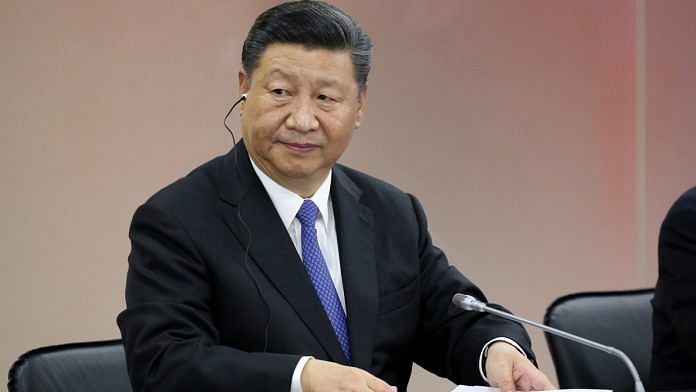Washington: The Trump administration rejected China’s expansive maritime claims in the South China Sea, reversing a previous policy of not taking sides in such disputes and escalating tensions with Beijing on yet another front.
The move aligns the U.S. with a 2016 ruling by a United Nations tribunal that found China’s claims to waters also contested by the Philippines were unlawful. It’s meant to push back against what the U.S. sees as an intensifying Chinese campaign to dominate the resource-rich South China Sea and smaller nations in the region.
“We are making clear: Beijing’s claims to offshore resources across most of the South China Sea are completely unlawful, as is its campaign of bullying to control them,” Secretary of State Michael Pompeo said in a statement Monday.
In the past, the U.S. largely limited itself to calling for ensuring “freedom of navigation” in the contested waterway, which is critical for global trade routes, while stopping short of taking a position on specific claims. China has proceeded nonetheless, engaging in a years-long campaign to build bases and other outposts on shoals, reefs and rock outcroppings as a way of deepening its claims.
A spokesperson for the Chinese Embassy in the U.S. called the Trump administration’s action “completely unjustified,” saying that it “exaggerates the situation in the region and attempts to sow discord between China and other littoral countries.” It added that Beijing is committed to resolving territorial disputes with Southeast Asian countries through direct negotiation and said the U.S. should “stop its attempts to disrupt and sabotage regional peace and stability.”
Also read: Fauci sidelined by White House, UK to ban Huawei, Lebanon’s food crisis & other Covid news
‘Flexing Muscles’
“The United States is not a country directly involved in the disputes. However, it has kept interfering in the issue,” the spokesperson said in a statement. “Under the pretext of preserving stability, it is flexing muscles, stirring up tension and inciting confrontation in the region.”
While the immediate impact of the U.S. decision isn’t clear, it adds to conflicts over issues from trade to cybersecurity and President Donald Trump’s efforts to blame China for the coronavirus pandemic that began there. Last week, the U.S. slapped sanctions on a top Chinese official over human rights abuses in the Xinjiang region, and China responded by imposing sanctions on Senators Marco Rubio and Ted Cruz.
Among the demands that the UN tribunal — and now the U.S. — are rejecting are China’s claims in waters surrounding Vanguard Bank off Vietnam and Luconia Shoals off Malaysia. The U.S. also says China can’t claim any maritime rights around Scarborough Shoal off the Philippines or features including Mischief Reef that are submerged at high tide.
Most recently, the U.S. had raised concern over China’s decision to conduct military exercises in the contested waters around the Paracel Islands in the South China Sea. The Defense Department last week called the actions “unlawful.”
The top State Department official for East Asia, Assistant Secretary David Stilwell, said in an interview that the U.S. hoped its announcement Monday would give cover to other nations in the region to contest their own claims against China. He said the change doesn’t mean the U.S. is taking sides in specific disputes over land — such as islands that China and other nations also claim.
“These laws exist to prevent the Chinese approach of big countries pretty much dominating small countries,” Stilwell said. “The threat of using that excessive weight, both economic and otherwise, has cowed them into not ending their claims but acquiescing for a time. What we are doing I believe gives them the space to assert their own claims.”
Stretching from China in the north to Indonesia in the south, the South China Sea encompasses 1.4 million square miles (3.6 million square kilometers). Over the last several years, China has engaged in an extensive campaign to build up many of the land features in the region as a way of extending its claims to the entire region.
“The move provides the legal basis for the U.S. to take more forceful steps to back other claimants’ rights to fish and develop energy” within their exclusive economic zones, said Bonnie Glaser, senior adviser for Asia and the director of the China Power Project at the Center for Strategic and International Studies in Washington.
Trump administration officials have long accused past administrations, and especially that of former President Barack Obama, of doing too little to challenge China’s territorial moves. This month, the U.S. announced it was sending the USS Ronald Reagan and USS Nimitz aircraft carriers to the South China Sea for military exercises as China ramps up its own drills in the area.
The question now is what the U.S. will do if China continues to violate the UN tribunal’s ruling. The U.S. has a decades-old defense treaty with the Philippines but no such agreement with other nations involved in territorial and maritime disputes with China.
Critics of the Trump administration approach have said they worry that neither side appears willing to back down, raising the possibility that tensions will only escalate further and could even lead to a clash at sea.
Stilwell said the U.S. wants to talk to China but said such discussions need to be productive.
“The door has remained open as long as I’ve been in this seat to an honest, results-based conversation,” Stilwell said. “The Chinese need to understand that we are serious and we are going to discuss these things in a serious manner.”-Bloomberg
Also read: ‘Photo-op’ to ‘Biden finished’ — How US reacted as Trump wore mask in public for first time






